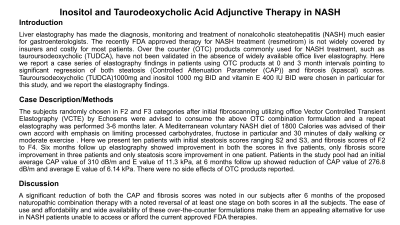Monday Poster Session
Category: Liver
P2983 - Inositol and Taurodeoxycholic Acid Adjunctive Therapy in NASH
Monday, October 28, 2024
10:30 AM - 4:00 PM ET
Location: Exhibit Hall E

Has Audio

Meena Kumari Bellamkonda, MBBS
Dr. Pinnamaneni Siddhartha Institute of Medical Sciences and Research Foundation
Holmdel, NJ
Presenting Author(s)
Meena Kumari Bellamkonda, MBBS1, Neal Vasireddi, 2, Nikhil Vasireddi, 3, Srinivas S. Vasireddi, 4
1Dr. Pinnamaneni Siddhartha Institute of Medical Sciences and Research Foundation, Holmdel, NJ; 2Rutgers RWJUH School of Medicine, Metuchen, NJ; 3Case Western Reserve University School of Medicine, Cleveland, OH; 4Advanced Digestive Center, Inc., Metuchen, NJ
Introduction: Liver elastography has made the diagnosis, monitoring and treatment of nonalcoholic steatohepatitis (NASH) much easier for gastroenterologists. The recently FDA approved therapy for NASH treatment (resmetirom) is not widely covered by insurers and costly for most patients. Over the counter (OTC) products commonly used for NASH treatment, such as tauroursodeoxycholic (TUDCA), have not been validated in the absence of widely available office liver elastography. Here we report a case series of elastography findings in patients using OTC products at 0 and 3 month intervals pointing to significant regression of both steatosis (Controlled Attenuation Parameter (CAP)) and fibrosis (kpascal) scores. Tauroursodeoxycholic (TUDCA)1000mg and inositol 1000 mg BID and vitamin E 400 IU BID were chosen in particular in this study and we report the elastography findings.
Case Description/Methods: The subjects randomly chosen in F2 and F3 categories after initial fibroscanning utilizing office Vector Controlled Transient Elastography (VCTE)by Echosens were advised to consume the above OTC combination formulation and a repeat elastography was performed 3-6 months later. A Mediterranean voluntary NASH diet of 1800 Calories was advised of their own accord with emphasis on limiting processed carbohydrates, fructose in particular and 30 minutes of daily walking or moderate exercise . Here we present ten patients with initial steatosis scores ranging S2 and S3, and fibrosis scores of F2 to F4. Six months follow up elastography showed improvement in both the scores in five patients, only fibrosis score improvement in three patients and only steatosis score improvement in one patient. Patients in the study pool had an initial average CAP value of 310 dB/m and E value of 11.3 kPa, at 6 months follow up showed reduction of CAP value of 276.8 dB/m and average E value of 6.14 kPa. There were no side effects of OTC products reported.
Discussion: A significant reduction of both the CAP and fibrosis scores was noted in our subjects after 6 months of the proposed naturopathic combination therapy with a noted reversal of at least one stage on both scores in all the subjects. The ease of use and affordability and wide availability of these over the counter formulations make them an appealing alternative for use in NASH patients unable to access or afford the current approved FDA therapies.
Disclosures:
Meena Kumari Bellamkonda, MBBS1, Neal Vasireddi, 2, Nikhil Vasireddi, 3, Srinivas S. Vasireddi, 4. P2983 - Inositol and Taurodeoxycholic Acid Adjunctive Therapy in NASH, ACG 2024 Annual Scientific Meeting Abstracts. Philadelphia, PA: American College of Gastroenterology.
1Dr. Pinnamaneni Siddhartha Institute of Medical Sciences and Research Foundation, Holmdel, NJ; 2Rutgers RWJUH School of Medicine, Metuchen, NJ; 3Case Western Reserve University School of Medicine, Cleveland, OH; 4Advanced Digestive Center, Inc., Metuchen, NJ
Introduction: Liver elastography has made the diagnosis, monitoring and treatment of nonalcoholic steatohepatitis (NASH) much easier for gastroenterologists. The recently FDA approved therapy for NASH treatment (resmetirom) is not widely covered by insurers and costly for most patients. Over the counter (OTC) products commonly used for NASH treatment, such as tauroursodeoxycholic (TUDCA), have not been validated in the absence of widely available office liver elastography. Here we report a case series of elastography findings in patients using OTC products at 0 and 3 month intervals pointing to significant regression of both steatosis (Controlled Attenuation Parameter (CAP)) and fibrosis (kpascal) scores. Tauroursodeoxycholic (TUDCA)1000mg and inositol 1000 mg BID and vitamin E 400 IU BID were chosen in particular in this study and we report the elastography findings.
Case Description/Methods: The subjects randomly chosen in F2 and F3 categories after initial fibroscanning utilizing office Vector Controlled Transient Elastography (VCTE)by Echosens were advised to consume the above OTC combination formulation and a repeat elastography was performed 3-6 months later. A Mediterranean voluntary NASH diet of 1800 Calories was advised of their own accord with emphasis on limiting processed carbohydrates, fructose in particular and 30 minutes of daily walking or moderate exercise . Here we present ten patients with initial steatosis scores ranging S2 and S3, and fibrosis scores of F2 to F4. Six months follow up elastography showed improvement in both the scores in five patients, only fibrosis score improvement in three patients and only steatosis score improvement in one patient. Patients in the study pool had an initial average CAP value of 310 dB/m and E value of 11.3 kPa, at 6 months follow up showed reduction of CAP value of 276.8 dB/m and average E value of 6.14 kPa. There were no side effects of OTC products reported.
Discussion: A significant reduction of both the CAP and fibrosis scores was noted in our subjects after 6 months of the proposed naturopathic combination therapy with a noted reversal of at least one stage on both scores in all the subjects. The ease of use and affordability and wide availability of these over the counter formulations make them an appealing alternative for use in NASH patients unable to access or afford the current approved FDA therapies.
Disclosures:
Meena Kumari Bellamkonda indicated no relevant financial relationships.
Neal Vasireddi indicated no relevant financial relationships.
Nikhil Vasireddi indicated no relevant financial relationships.
Srinivas Vasireddi indicated no relevant financial relationships.
Meena Kumari Bellamkonda, MBBS1, Neal Vasireddi, 2, Nikhil Vasireddi, 3, Srinivas S. Vasireddi, 4. P2983 - Inositol and Taurodeoxycholic Acid Adjunctive Therapy in NASH, ACG 2024 Annual Scientific Meeting Abstracts. Philadelphia, PA: American College of Gastroenterology.
